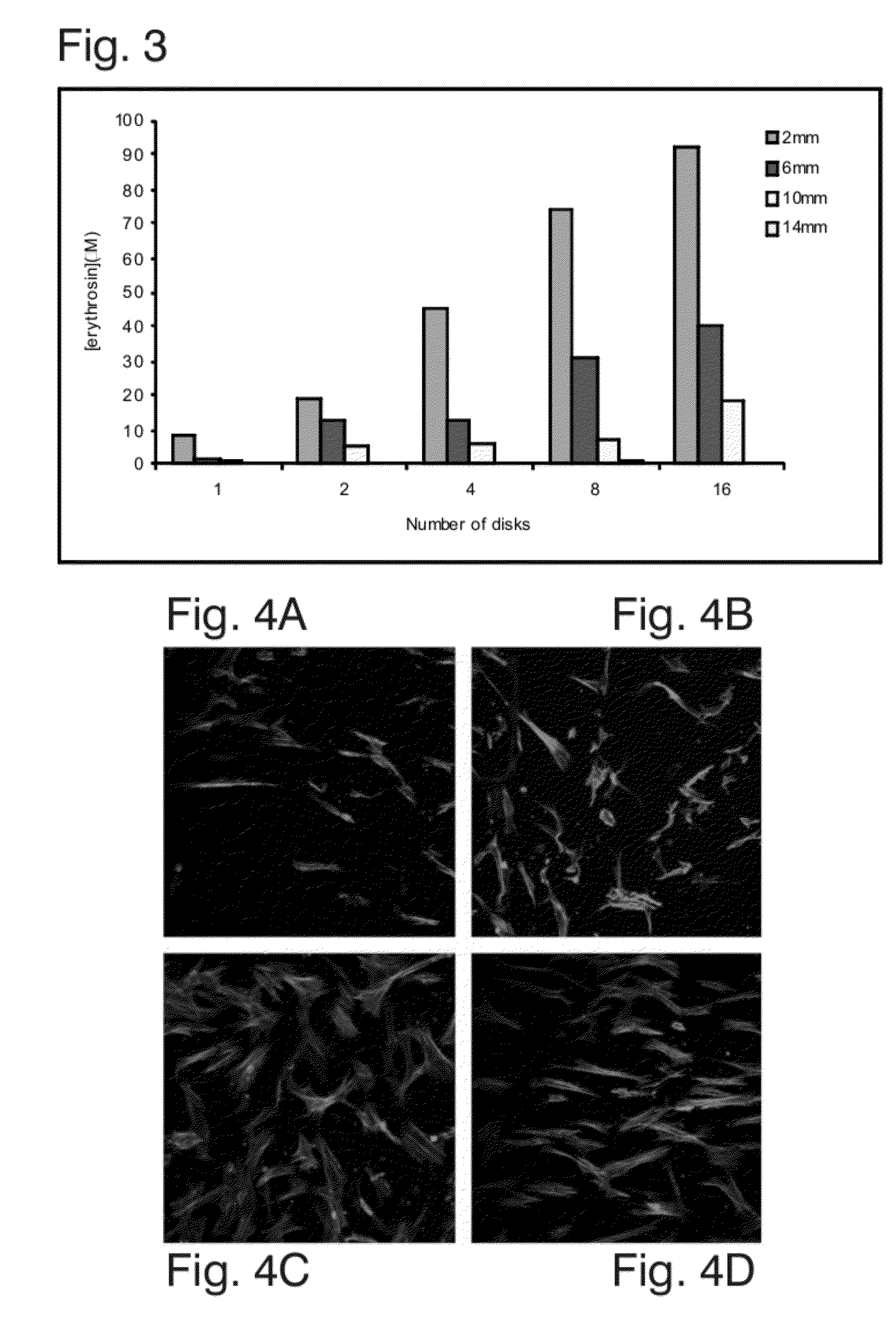Scaffold
a technology of scaffolds and spherical plates, applied in the field of spherical plates, can solve the problems of not always being effective, light nor photosensitiser, high failure risk, etc., and achieve the effect of reducing the need for use, high efficacy of treatment, and cost and time saving for health systems globally
- Summary
- Abstract
- Description
- Claims
- Application Information
AI Technical Summary
Benefits of technology
Problems solved by technology
Method used
Image
Examples
example 1
[0082]Experiments were conducted to determine the active agent content of the scaffold and to assess the chemical stability using a reverse phase HPLC method for the determination of erythrosine levels in polymer scaffold samples. FIG. 1 shows a scanning electron microscope image of the fibrous PGA scaffold, the scale bar corresponds to a length of 10 μm.
[0083]In order to determine the quantity of erythrosine encapsulated within the manufactured scaffolds, two methods for extracting erythrosine were employed. Using the PBS method hereinbefore described, it is clear that PBS is able to effectively extract erythrosine from the scaffolds giving an average value of active agent content of 5% w / w for each reference sample. However, a minimum of 2 weeks is required for extraction of the entire contents of the scaffold, which can be observed by the colour change of the samples from pink to white. Using the more rapid ammonia extraction method, in which the scaffolds were immersed in a solu...
example 2
[0086]Experiments were conducted to quantify the amount of erythrosine released from the scaffold over time into a range of liquids chosen to approximate physiological conditions, such as saliva or tissue fluid. The fluids were either distilled water-PBS pH 7.4, PBS plus 5% or 10% foetal calf serum (FCS) and a distilled water control. The results for the release of erythrosine from scaffold is shown in FIG. 2. Erythrosine is released at a rate of approximately 7 μg / mg of scaffold over the first 4 days in all three buffered solutions. This is reduced dramatically after the fourth day and between the fourth and eighth day approximately a further 7 μg / mg of scaffold is released. After day eight the scaffold showed visible signs of deterioration with large fractures appearing and sections breaking off. Remaining scaffold had a very lightly pink colour as opposed to a vivid pink colour at the start of the experiment indicating that there was very little erythrosine remaining in the scaff...
example 3
[0087]Experiments were conducted to observe and quantify release of erythrosine from scaffold and its diffusion through a gelatinous medium which approximates soft tissue.
[0088]Results showed that erythrosine was released from the scaffold and diffused out into the surrounding agar up to a maximum detected distance of 14 mm (FIG. 3). Although it is postulated that the main site of action is more likely to be very close or in direct contact with the scaffold, it is believed that the ability of erythrosine to diffuse in this way may provide some protection from infection to surrounding healthy tissue.
PUM
| Property | Measurement | Unit |
|---|---|---|
| Fraction | aaaaa | aaaaa |
| Fraction | aaaaa | aaaaa |
| Diameter | aaaaa | aaaaa |
Abstract
Description
Claims
Application Information
 Login to View More
Login to View More - R&D
- Intellectual Property
- Life Sciences
- Materials
- Tech Scout
- Unparalleled Data Quality
- Higher Quality Content
- 60% Fewer Hallucinations
Browse by: Latest US Patents, China's latest patents, Technical Efficacy Thesaurus, Application Domain, Technology Topic, Popular Technical Reports.
© 2025 PatSnap. All rights reserved.Legal|Privacy policy|Modern Slavery Act Transparency Statement|Sitemap|About US| Contact US: help@patsnap.com



